A Study of Accelerated Corrosion of Stainless Steels under Highly Oxidizing Conditions
Abstract
:1. Introduction
2. Materials and Methods
3. Results and Discussion
3.1. General Framework
3.2. Corrosion Experiments
3.3. Microscopic Characterization
4. Conclusions
Author Contributions
Funding
Institutional Review Board Statement
Data Availability Statement
Conflicts of Interest
References
- Dillon, C.P. Corrosion Resistance of Stainless Steels; CRC Press: Boca Raton, FL, USA, 1995. [Google Scholar]
- Sedriks, A.J. Corrosion of Stainless Steels; John Wiley & Sons: Hoboken, NJ, USA, 1996. [Google Scholar]
- Ryan, M.P.; Williams, D.E.; Chater, R.J.; Hutton, B.M.; McPhail, D.S. Why stainless steel corrodes. Nature 2002, 415, 770–774. [Google Scholar] [CrossRef] [PubMed]
- Harsimran, S.; Santosh, K.; Rakesh, K. Overview of corrosion and its control: A critical review. Proc. Eng. Sci. 2021, 3, 13–24. [Google Scholar] [CrossRef]
- Olsson, C.-O.; Landolt, D. Passive films on stainless steels—Chemistry, structure and growth. Electrochim. Acta 2003, 48, 1093–1104. [Google Scholar] [CrossRef]
- Maher, M.; Iraola-Arregui, I.; Ben Youcef, H.; Rhouta, B.; Trabadelo, V. The synergistic effect of wear-corrosion in stainless steels: A review. Mater. Today Proc. 2022, 51, 1975–1990. [Google Scholar] [CrossRef]
- Berg, A. Corrosion Mechanisms and Their Consequences for Nuclear Power Plants with Light Water Reactors. In Proceedings of the SSARS 2009, Summer Safety and Reliability Seminars, Gdansk-Sopot, Poland, 19–25 July 2009. [Google Scholar]
- Ziemniak, S.; Hanson, M. Corrosion behavior of 304 stainless steel in high temperature, hydrogenated water. Corros. Sci. 2002, 44, 2209–2230. [Google Scholar] [CrossRef]
- Loto, R.T. Pitting corrosion evaluation of austenitic stainless steel type 304 in acid chloride media. J. Mater. Environ. Sci. 2013, 4, 448–459. [Google Scholar]
- Bateni, M.R.; Szpunar, J.; Wang, X.; Li, D. Wear and corrosion wear of medium carbon steel and 304 stainless steel. Wear 2006, 260, 116–122. [Google Scholar] [CrossRef]
- Barnard, P. Materials for Ultra-Supercritical and Advanced Ultra-Supercritical Power Plants; Woodhead Publishing: Cambridge, UK, 2017; ISBN 978-0-08-100552-1. [Google Scholar] [CrossRef]
- Sartorio, C.; Angiolini, M.; Flammini, D.; Pietropaolo, A.; Agostini, P.; Alberghi, C.; Candido, L.; Capogni, M.; Capone, M.; Cataldo, S.; et al. Preliminary Assessment of Radiolysis for the Cooling Water System in the Rotating Target of SORGENTINA-RF. Environments 2022, 9, 106. [Google Scholar] [CrossRef]
- Le Caër, S. Water Radiolysis: Influence of Oxide Surfaces on H2 Production under Ionizing Radiation. Water 2011, 3, 235–253. [Google Scholar] [CrossRef]
- Raiman, S.S.; Bartels, D.M.; Was, G.S. Radiolysis driven changes to oxide stability during irradiation-corrosion of 316L stainless steel in high temperature water. J. Nucl. Mater. 2017, 493, 40–52. [Google Scholar] [CrossRef]
- Bellanger, G. Localized corrosion of 316L stainless steel in tritiated water containing aggressive radiolytic and decomposition products at different temperatures. J. Nucl. Mater. 2008, 374, 20–31. [Google Scholar] [CrossRef]
- Macdonald, D.D.; Engelhardt, G.R. A Critical Review of Radiolysis Issues in Water-Cooled Fission and Fusion Reactors: Part II, Prediction of Corrosion Damage in Operating Reactors. Corros. Mater. Degrad. 2022, 3, 694–758. [Google Scholar] [CrossRef]
- Hata, K.; Inoue, H. A simulation of radiolysis of chloride solutions containing ferrous ion. J. Nucl. Sci. Technol. 2019, 56, 842–850. [Google Scholar] [CrossRef]
- Lavigne, O.; Takeda, Y.; Shoji, T. Simulation of Water Radiolysis by Sonochemistry: Effects on the Electrochemical Behavior of a Stainless Steel. In Proceedings of the 15th International Conference on Environmental Degradation, Colorado Springs, CO, USA, 7–11 August 2011; Busby, J.T., Ilevbare, G., Andresen, P.L., Eds.; TMS (The Minerals, Metals & Materials Society). Springer: Cham, Switzerland, 2011. [Google Scholar]
- Iwamatsu, K.; Sundin, S.; LaVerne, J.A. Hydrogen peroxide kinetics in water radiolysis. Radiat. Phys. Chem. 2018, 145, 207–212. [Google Scholar] [CrossRef]
- Dzaugis, M.E.; Spivack, A.J.; D’Hondt, S. A quantitative model of water radiolysis and chemical production rates near radionuclide-containing solids. Radiat. Phys. Chem. 2015, 115, 127–134. [Google Scholar] [CrossRef] [PubMed]
- Nicol, M.J. The role and use of hydrogen peroxide as an oxidant in the leaching of minerals. 1. acid solutions. Hydrometallurgy 2020, 193, 105328. [Google Scholar] [CrossRef]
- Pang, S.C.; Chin, S.F.; Anderson, M.A. Redox equilibria of iron oxides in aqueous-based magnetite dispersions: Effect of pH and redox potential. J. Colloid Interface Sci. 2007, 311, 94–101. [Google Scholar] [CrossRef]
- Dong, C.; Yuan, C.; Bai, X.; Li, J.; Qin, H.; Yan, X. Coupling mechanism between wear and oxidation processes of 304 stainless steel in hydrogen peroxide environments. Sci. Rep. 2017, 7, 2327. [Google Scholar] [CrossRef] [PubMed]
- Satoh, T.; Uchida, S.; Sugama, J.-I.; Yamashiro, N.; Hirose, T.; Morishima, Y.; Satoh, Y.; Iinuma, K. Effects of Hydrogen Peroxide on Corrosion of Stainless Steel. J. Nucl. Sci. Technol. 2004, 41, 610–618. [Google Scholar] [CrossRef]
- Anzai, H.; Nakata, K.; Kuniya, J.; Hattori, S. The effect of hydrogen peroxide on the stress corrosion cracking of 304 stainless steel in high temperature water. Corros. Sci. 1994, 36, 1201–1211. [Google Scholar] [CrossRef]
- Makjan, S.; Boonsri, P.; Channuie, J.; Kanjana, K. Effects of hydrogen peroxide on 304 stainless steel in high temperature water. J. Phys. Conf. Ser. 2019, 1380, 012087. [Google Scholar] [CrossRef]
- Esfandiari, K.; Banihashemi, M.; Soleimani, P. Influence of impressed current cathodic protection (ICCP) systems on chemical characteristics of underground water. Water Environ. Res. 2020, 92, 2105–2111. [Google Scholar] [CrossRef] [PubMed]
- Cook, W.G.; Olive, R.P. Pourbaix diagrams for the iron–water system extended to high-subcritical and low-supercritical conditions. Corros. Sci. 2012, 55, 326–331. [Google Scholar] [CrossRef]
- Harris, M.G.; Torres, J.; Tracewell, L. pH and H2O2 concentration of hydrogen peroxide disinfection Systems. Optom. Vis. Sci. 1988, 65, 527–535. [Google Scholar] [CrossRef] [PubMed]
- Li, R. Time-temperature superposition method for glass transition temperature of plastic materials. Mater. Sci. Eng. A 2000, 278, 36–45. [Google Scholar] [CrossRef]
- Olsen, N.B.; Christensen, T.; Dyre, J.C. Time-Temperature Superposition in Viscous Liquids. Phys. Rev. Lett. 2001, 86, 1271–1274. [Google Scholar] [CrossRef] [PubMed]
- Christensen, R.M. Theory of Viscoelasticity: An Introduction; Academic Press: New York, NY, USA, 1971; ISBN 0121742504. [Google Scholar]
- Susanto, H. Chemistry and Industrial Techniques for Chemical Engineers; Apple Academic Press: New York, NY, USA, 2020. [Google Scholar] [CrossRef]
- Singh, A.K.; Chaudhary, V.; Sharma, A. Electrochemical Studies of Stainless Steel Corrosion in Peroxide Solutions. Port. Electrochim. Acta 2012, 30, 99–109. [Google Scholar] [CrossRef]
- Kain, V. Stress corrosion cracking (SCC) in stainless steels. In Stress Corrosion Cracking Theory and Practice; Woodhead Publishing Series in Metals and Surface Engineering; Woodhead Publishing: Cambridge, UK, 2011; pp. 199–244. [Google Scholar]
- Song, R.-B.; Xiang, J.-Y.; Hou, D.-P. Characteristics of Mechanical Properties and Microstructure for 316L Austenitic Stainless Steel. J. Iron Steel Res. Int. 2011, 18, 53–59. [Google Scholar] [CrossRef]
- Ahssi, M.A.M.; Erden, M.A.; Acarer, M.; Çuğ, H. The Effect of Nickel on the Microstructure, Mechanical Properties and Corrosion Properties of Niobium-Vanadium Microalloyed Powder Metallurgy Steels. Materials 2020, 13, 4021. [Google Scholar] [CrossRef] [PubMed]
- Bukovská, Š.; Moravec, J.; Švec, M. Kinetics of Nickel Diffusion into Austenitic Stainless Steels AISI 304 and 316L and Calculation of Diffusion Coefficients. Materials 2023, 16, 6783. [Google Scholar] [CrossRef]
- Tiamiyu, A.A.; Eduok, U.; Szpunar, J.A.; Odeshi, A.G. Corrosion behavior of metastable AISI 321 austenitic stainless steel: Investigating the effect of grain size and prior plastic deformation on its degradation pattern in saline media. Sci. Rep. 2019, 9, 12116. [Google Scholar] [CrossRef] [PubMed]
- Eguchi, K. Quantitative analysis of initiation site of pitting corrosion on type 304 austenitic stainless steel. Corros. Sci. 2023, 221, 111312. [Google Scholar] [CrossRef]
- Gale, W.F.; Totemeier, T.C. (Eds.) 31 Corrosion. In Smithells Metals Reference Book, 8th ed.; Butterworth-Heinemann: Oxford, UK, 2004. [Google Scholar] [CrossRef]
- Wilson, F.G. Mechanism of Intergranular Corrosion of Austenitic Stainless Steels—Literature Review. Br. Corros. J. 1971, 6, 100–108. [Google Scholar] [CrossRef]
- VCruz-Hernández, V.; García-Hernández, R.; López-Morelos, V.; García-Rentería, M.; González-Sánchez, J. Intergranular corrosion of AISI 347 stainless steel welds obtained under electromagnetic interaction of low intensity. Mater. Lett. 2022, 312, 131679. [Google Scholar] [CrossRef]
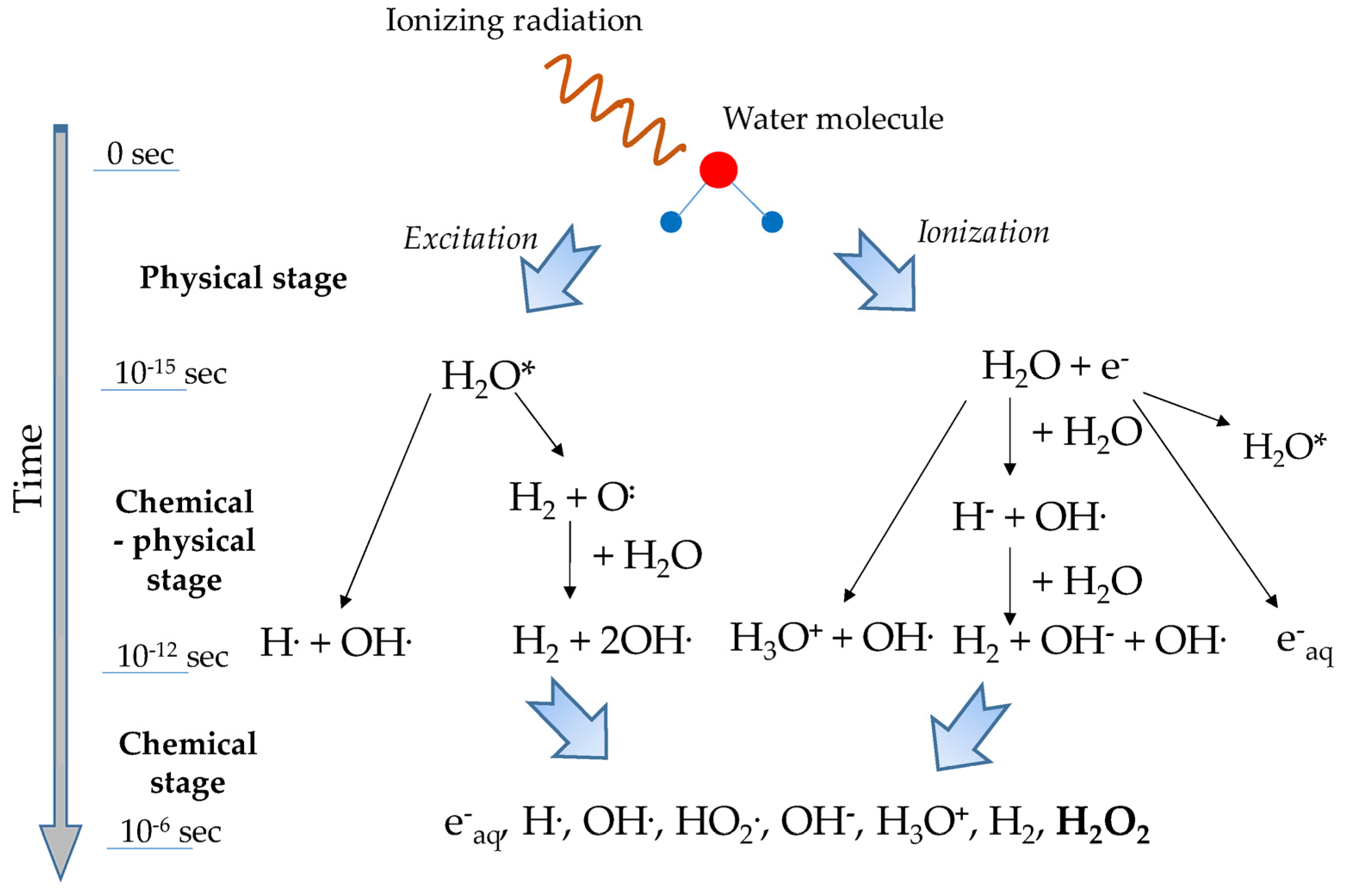

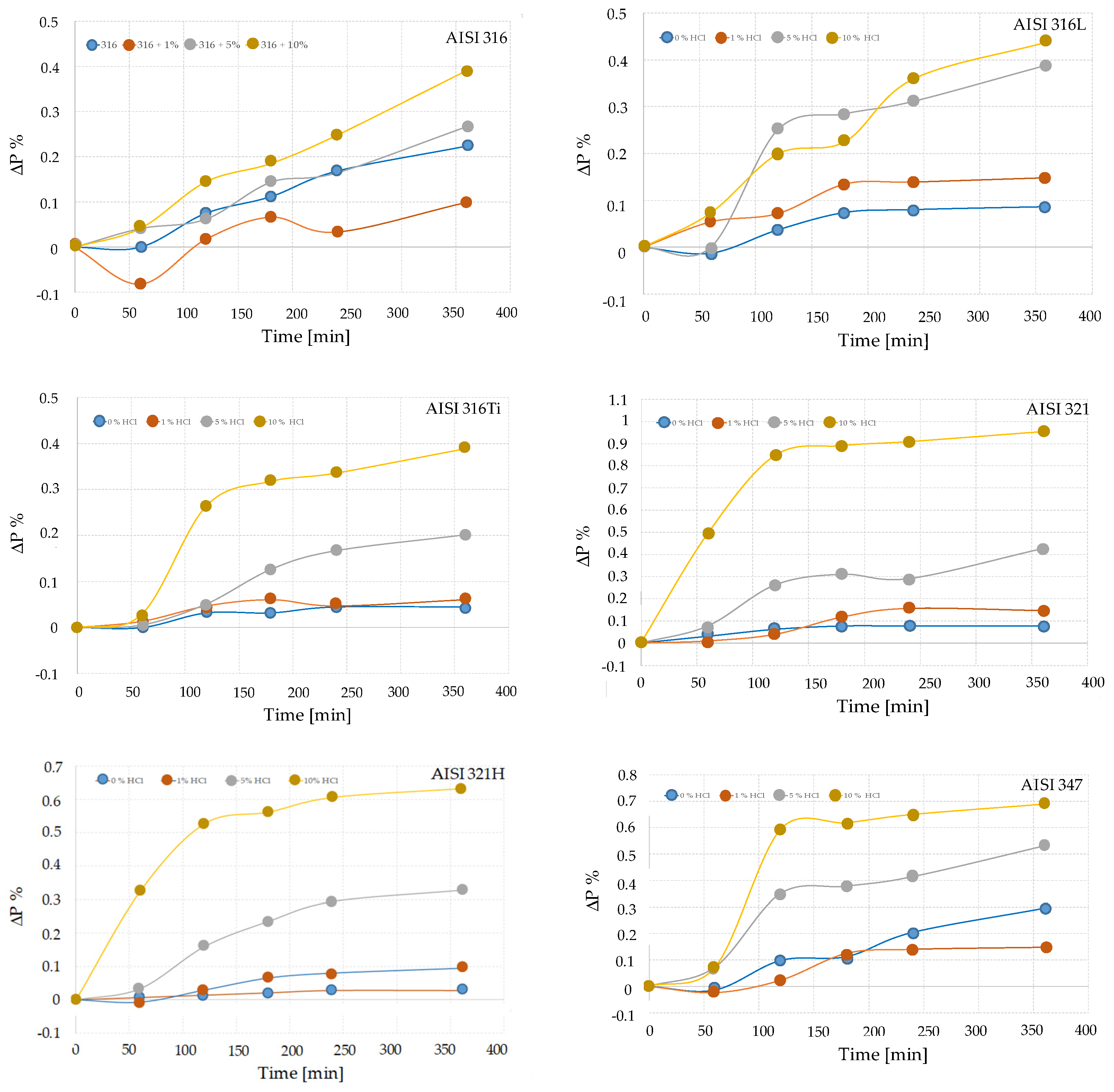
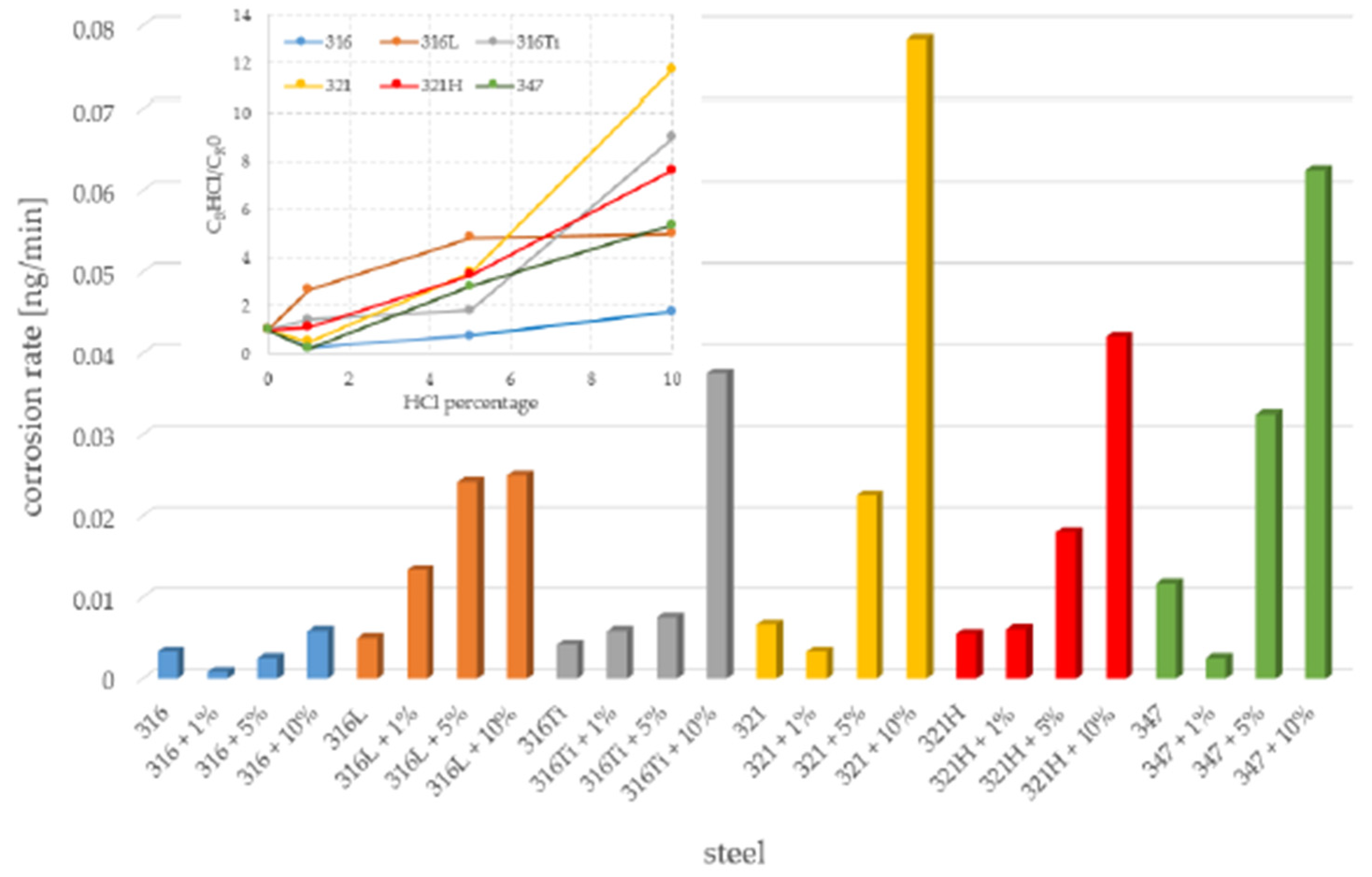
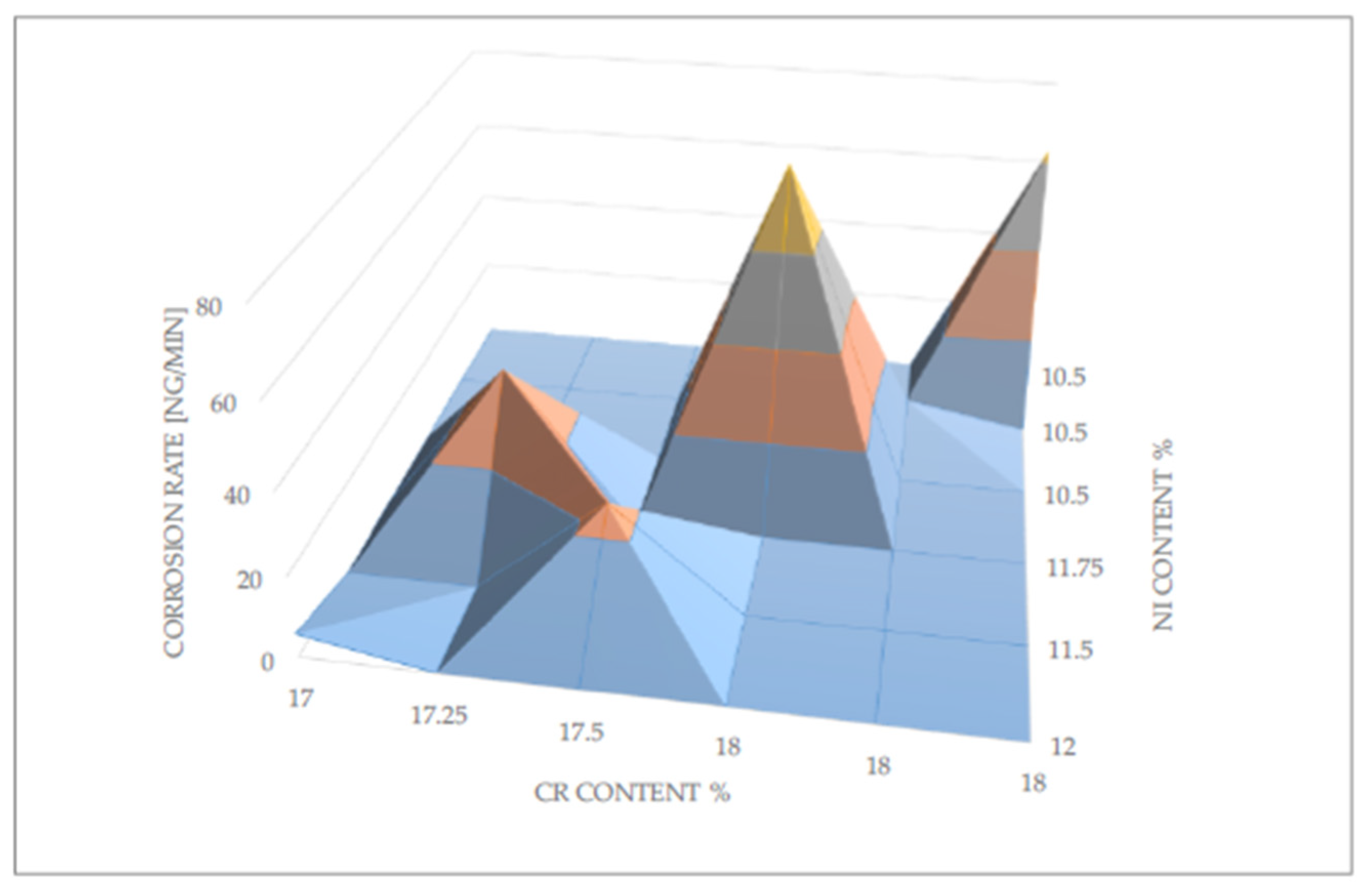


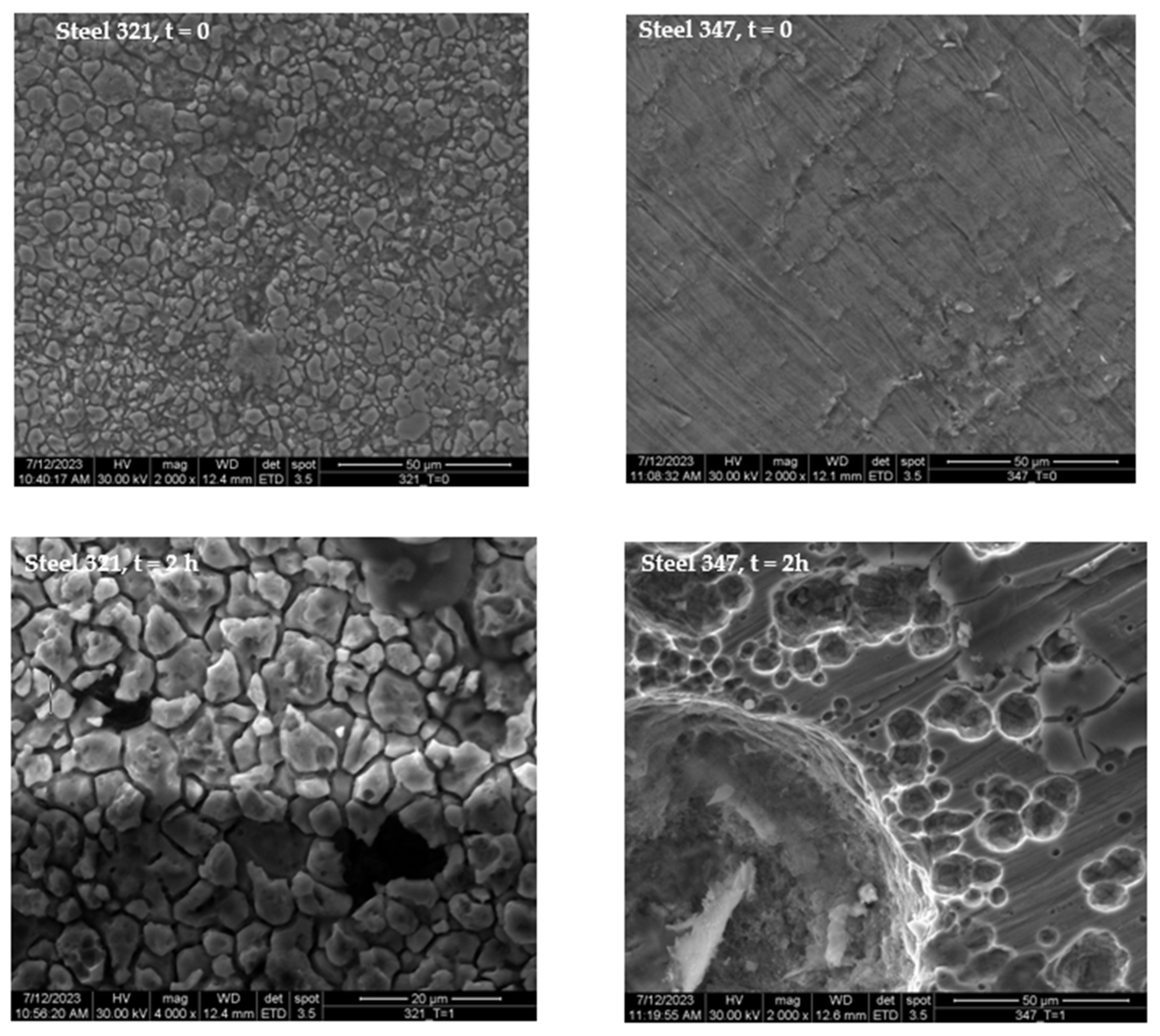
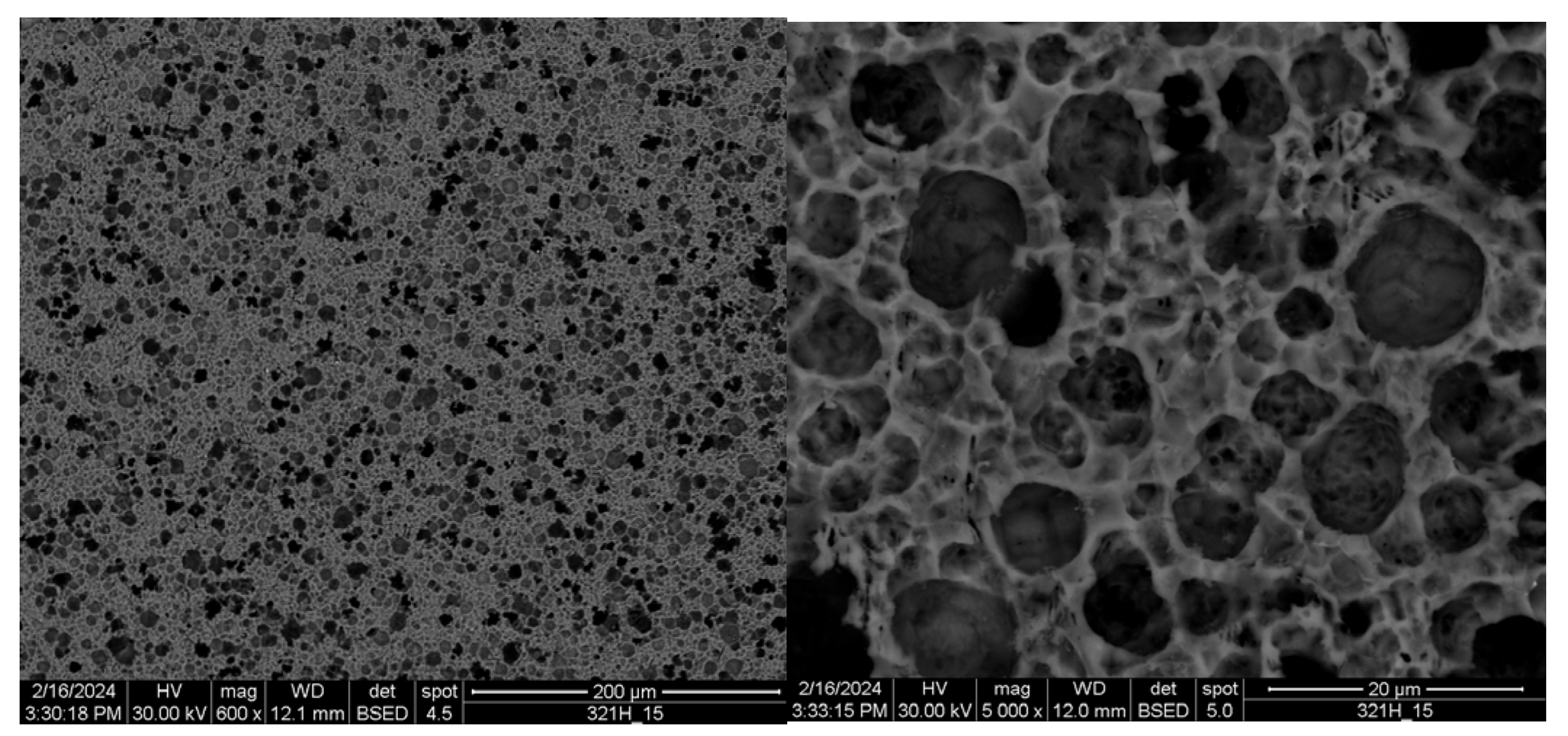

| Sample | AISI Grade | Element Percentages [%] | |||||||||
|---|---|---|---|---|---|---|---|---|---|---|---|
| Cr | Ni | C | Si | Mn | P | S | Mo | N | Ti | ||
| 1 | 316 | 16–18 | 10–14 | 0.08 | 0.75 | 2 | 0.045 | 0.03 | 2–3 | 0.1 | |
| 2 | 316L | 16.5–18.5 | 10–13 | 0.03 | 1 | 2 | 0.045 | 0.015 | 2–2.5 | 0.1 | |
| 3 | 316Ti | 16.5–18 | 10.50–13.5 | 0.08 | 1 | 2 | 0.045 | 0.015 | 2–2.5 | 0.2–0.7 | |
| 4 | 321 | 17–19 | 9–12 | <0.08 | <1 | <2 | <0.045 | <0.015 | 0–0.3 | 0.15–0.7 | |
| 5 | 321H | 17–19 | 9–12 | 0.1 | 1 | 2 | 0.045 | 0.015 | 0–0.3 | 0.5–08 | |
| 6 | 347 | 17–19 | 9–12 | 0.08 | 1 | 2 | 0.045 | 0.015 | 0–0.25 | ||
Disclaimer/Publisher’s Note: The statements, opinions and data contained in all publications are solely those of the individual author(s) and contributor(s) and not of MDPI and/or the editor(s). MDPI and/or the editor(s) disclaim responsibility for any injury to people or property resulting from any ideas, methods, instructions or products referred to in the content. |
© 2024 by the authors. Licensee MDPI, Basel, Switzerland. This article is an open access article distributed under the terms and conditions of the Creative Commons Attribution (CC BY) license (https://creativecommons.org/licenses/by/4.0/).
Share and Cite
Ubaldini, A.; Telloli, C.; Rizzo, A.; Gessi, A.; Marghella, G.; Bruni, S.; Calistri, S.; Gennerini, F.; Pintilei, G. A Study of Accelerated Corrosion of Stainless Steels under Highly Oxidizing Conditions. Coatings 2024, 14, 390. https://doi.org/10.3390/coatings14040390
Ubaldini A, Telloli C, Rizzo A, Gessi A, Marghella G, Bruni S, Calistri S, Gennerini F, Pintilei G. A Study of Accelerated Corrosion of Stainless Steels under Highly Oxidizing Conditions. Coatings. 2024; 14(4):390. https://doi.org/10.3390/coatings14040390
Chicago/Turabian StyleUbaldini, Alberto, Chiara Telloli, Antonietta Rizzo, Alessandro Gessi, Giuseppe Marghella, Stefania Bruni, Sara Calistri, Francesco Gennerini, and Georgiana Pintilei. 2024. "A Study of Accelerated Corrosion of Stainless Steels under Highly Oxidizing Conditions" Coatings 14, no. 4: 390. https://doi.org/10.3390/coatings14040390






